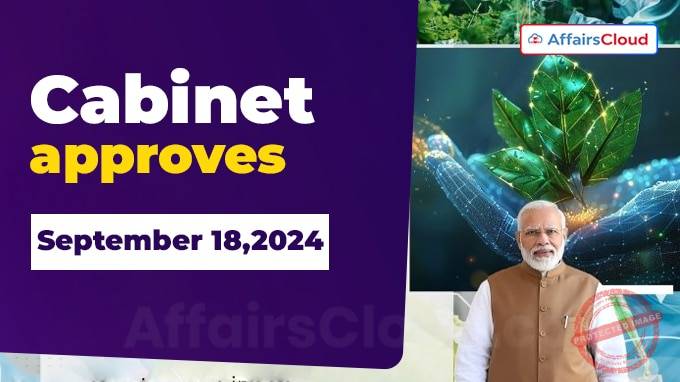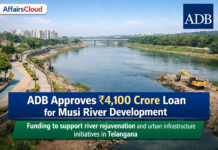 On 18th September 2024, the Union Cabinet chaired by the Prime Minister (PM) Narendra Modi has approved the following:
On 18th September 2024, the Union Cabinet chaired by the Prime Minister (PM) Narendra Modi has approved the following:
- Recommendations of High-Level Committee on Simultaneous Elections.
- Bio-RIDE scheme to support cutting-edge research and development in Biotechnology.
- Pradhan Mantri Janjatiya Unnat Gram Abhiyan with a total outlay of Rs.79,156 crore for 5 years.
- Continuation of schemes of Pradhan Mantri Annadata Aay SanraksHan Abhiyan (PM-AASHA).
- Chandrayaan-4 to develop and demonstrate the technologies to come back to Earth after successfully landing on the Moon.
- Development of Venus Orbiter Mission (VOM) for exploring and studying Venus.
- Development of Next Generation Launch Vehicle (NGLV) for Bharat.
- Building the first unit of the Bharatiya Anatriksh Station (BAS).
- Establishment of the National Centre of Excellence (NCoE) for Animation, Visual Effects, Gaming, Comics and Extended Reality (AVGC-XR).
- Fixing the Nutrient Based Subsidy (NBS) rates for RABI Season, 2024 (from 01.10.2024 to 31.03.2025) on Phosphatic and Potassic (P&K) fertilisers.
Cabinet Accepts Recommendations of High-Level Committee on Simultaneous Elections
The Union Cabinet has accepted the recommendations of the High-Level Committee on Simultaneous Elections under the chairmanship of former President Ram Nath Kovind.
Key Recommendations:
i.Elections have been held simultaneously between 1951 and 1967.
ii.Law Commission: 170th report (1999): One election to Lok Sabha and all Legislative Assemblies in five years.
iii.Parliamentary Committee 79th Report (2015) suggested the methods for simultaneous elections in two phases.
- In first phase: conduct Lok Sabha and Assembly elections simultaneously.
- In second phase: Conduct local body elections (panchayat and municipalities) within 100 days of general elections.
iv.High-Level Committee extensively consulted a broad spectrum of stakeholders including political parties and experts.
v.Extensive feedback collected showed widespread support for simultaneous elections in the country.
vi.There will be a common electoral roll for all elections.
vii.An implementation group will be constituted for the successful execution of the plan.
Note
The report is available online at: https://onoe.gov.in
Cabinet approves ‘Bio-RIDE’ scheme to support cutting edge research and development in Biotechnology
The Union Cabinet has approved the continuation of the two umbrella schemes of the Department of Biotechnology (DBT), merged as one scheme- ‘Biotechnology Research Innovation and Entrepreneurship Development (Bio- RIDE)’ with a new component called Biomanufacturing and Biofoundry.
The scheme has three broad components:
- Biotechnology Research and Development (R&D)
- Industrial & Entrepreneurship Development (I&ED)
- Biomanufacturing and Biofoundry
The proposed outlay for the implementation of the unified scheme ‘Bio-RIDE’ is Rs.9197 crore during a period from 2021-22 to 2025-26.
Aim of the Scheme
To accelerate research, enhance product development, bridge the gap between academic research and industrial applications and to develop the potential of bio-innovation to tackle national and global challenges such as healthcare, agriculture, environmental sustainability, and clean energy.
Advantages of the Scheme
i.Promote Bio-Entrepreneurship: Bio-RIDE will provide seed funding, incubation support, and mentorship to bio-entrepreneurs.
ii.Advance Innovation:Bio-RIDE will provide grants and incentives for cutting-edge research and development in areas like synthetic biology, biopharmaceuticals, bioenergy, and bioplastics.
iii.Facilitate Industry-Academia Collaboration: Create harmony between academic institutions, research organizations, and industry to enhance the commercialization of bio-based products and technologies.
iv.Encourage Sustainable Biomanufacturing: Promoting environmentally sustainable practices in biomanufacturing, aligned with India’s green goals.
v.Support researchers through External funding: Bio-RIDE will play a major role in advancing scientific research, innovation, and technological development across diverse fields of biotechnology by providing external funding to research institutions, universities, and individual researchers in areas such as agriculture, healthcare, bioenergy, and environmental sustainability.
vi.Nurturing Human Resource in Biotechnology sector: Bio-RIDE will provide holistic development and support to students, young researchers and scientists working in the multidisciplinary areas of Biotechnology.
Cabinet approves Pradhan Mantri Janjatiya Unnat Gram Abhiyan
The Union Cabinet has approved Pradhan Mantri Janjatiya Unnat Gram Abhiyan with a total outlay of Rs.79,156 crore (Central Share: Rs.56,333 crore and State Share: Rs. 22,823 crore) for improving the socio-economic condition of tribal communities, by adopting saturation coverage for tribal families in tribal-majority villages and aspirational districts.
- This will cover around 63,000 villages benefitting more than 5 crore tribal people as announced in the Budget Speech 2024-25.
- It will cover 549 districts and 2,740 blocks spread across all tribal majority villages across 30 States / UTs.
Key Goals of the Scheme
i.Goal-I: Developing Enabling Infrastructure
- Pucca house for eligible Households with other entitlements: Eligible Scheduled Tribe (ST) household shall have access to pucca housing under the Pradhan Mnatri Awas Yojana- Gramin (PMAY-G) with availability of tapped water (Jal Jeevan Mission) and electricity supply.Eligible ST household shall also have access to Ayushman Bharat Card (PMJAY).
- Improving Village infrastructure: Ensuring all weather road connectivity to ST majority villages, provide access to mobile connectivity (Bharat Net) and internet, infrastructure for improving health, nutrition, and education.
ii.Goal-2: Promotion of Economic Empowerment
Skill Development Entrepreneurship promotion and enhanced livelihood(self-employment), providing access to training and ensuring that ST boys/girls get access to long-term skill courses after 10th/12th standard every year. Further, marketing support through Tribal Multipurpose Marketing Centre (TMMC), Tourist Home Stays and Agriculture, Animal Husbandry and Fishery support for Forest Rights Act (FRA) Patta holders will also be given.
iii.Goal-3: Universalization of Access to Good Education
To increase Gross Enrolment Ratio (GER) to the national levels in school and higher education and to make quality education affordable and accessible to ST students by setting up tribal hostels in schools at district/block level.
iv.Goal 4: Healthy Lives and Dignified Ageing:
To ensure enhanced access to quality health facilities to ST households, reach towards the national standards in Infant mortality rate (IMR), Maternal Mortality Rate (MMR) and coverage of immunisation through Mobile Medical Units in areas where sub-centre is more than 10 km in plain areas and 5 kms in Hilly areas (National Health Mission).
Note: The Mission comprises of 25 interventions which will be implemented by 17-line ministries.
Cabinet approves continuation of schemes of Pradhan Mantri Annadata Aay SanraksHan Abhiyan (PM-AASHA)
The Union Cabinet has approved the continuation of schemes of Pradhan Mantri Annadata Aay SanraksHan Abhiyan (PM-AASHA) to provide remunerative prices to farmers and to control price instability of essential commodities for consumers.
- The total financial outlay will be Rs. 35,000 crores during the 15th Finance Commission Cycle up to 2025-26.
- PM-AASHA will now have the components of the Price Support Scheme (PSS), Price Stabilization Fund (PSF), Price Deficit Payment Scheme (POPS) and Market Intervention Scheme (MIS).
Key Points:
i.The procurement of notified pulses, oilseeds & copra at Minimum Support Price (MSP) under the Price Support Scheme will be on 25% of the national Production of these notified crops from the 2024-25 season onwards
ii.However, this ceiling will not be applicable in the case of Tur, Urad & Masur for 2024-25 season as there will be a 100 % procurement of Tur, Urad & Masur during in 2024-25 season.
iii.The Government has renewed and increased the existing government guarantee to Rs.45,000 crore for procurement of notified pulses, oilseeds & copra at MSP from farmers.
iv.Procurement of pulses at market price will be done by the Department of Consumer Affairs (DoCA) including pre-registered farmers on the eSamridhi portal of NAFED and the eSamyukti portal of NCCF whenever prices rule above MSP in the market.
v.The coverage under the Price Deficiency Payment Scheme (PDPS) has been enhanced from the existing 25% of state production of oilseeds to 40% and also enhanced the implementation period from 3 months to 4 months for the benefit of farmers. The compensation of the difference between MSP and Sale/Modal price to be provided by the Central Government is limited to 15% of MSP.
vi.The Government has increased the coverage from 20% to 25% of production and has added a new option of making differential payments directly into the farmers’ account instead of physical procurement under the Market Intervention Scheme (MIS).
Cabinet Approved Chandrayaan-4, a Mission to the Moon
The Union Cabinet has approved the mission to the moon, named Chandrayaan-4 to develop and demonstrate the technologies to come back to Earth after successfully landing on the Moon and also collect moon samples and analyse them on Earth.
- The Chandrayaan-4 mission will achieve the foundational technologies capabilities for a landing on the moon by the year 2040 and return safely back to Earth.
- Major technologies that are required for docking/undocking, landing, safe return to earth and also accomplish lunar sample collection and analysis would be demonstrated.
- To realize this vision, a series of Gaganyaan & Chandrayaan follow-on missions are planned including the development of associated space transportation & infrastructure capabilities.
Note: The total fund requirement for the technology demonstration mission “Chandrayaan-4” is Rs. 2104.06 Crore.
- The cost includes spacecraft development and realisation, two launch vehicle missions of LVM3, external deep space network support and conducting special tests for design validation.
Cabinet Approves Development of Venus Orbiter Mission (VOM) for exploring and studying Venus
The Union Cabinet has approved the development of the Venus Orbiter Mission (VOM) by the Department of Space, to explore and study the Venus.
- The mission is envisaged to orbit a scientific spacecraft in the orbit of Venus for better understanding of the Venusian surface and subsurface, atmospheric processes and influence of Sun on Venusian atmosphere.
Key Points
i.Indian Space Research Organisation (ISRO) will be responsible for the development of spacecraft and its launch and is expected to be accomplished on the opportunity available during March 2028.
ii.The total fund approved for the VOM is Rs.1236 crore, of which Rs 824.00 crore will be spent on the spacecraft.
- The cost includes development and realization of the spacecraft including its specific payloads and technology elements, global ground station support cost for navigation and network as well as the cost of launch vehicle.
Cabinet Approved Development of Next Generation Launch Vehicle (NGLV)
The Union Cabinet has approved the development of the Next Generation Launch Vehicle (NGLV) to establish and operate the Bharatiya Antariksh Station and towards developing capability for Indian Crewed Landing on the Moon by 2040.
- The total outlay for the project is Rs. 8240.00 crore and includes the development costs, three developmental flights, essential facility establishment, Programme Management and Launch Campaign.
About Next Generation Launch Vehicle:
i. NGLV will have 3 times the present payload capability with 5 times the cost compared to Launch Vehicle Mark-3 (LVM3), and will also have reusability resulting in low-cost access to space and modular green propulsion systems.
ii.The NGLV is designed to have a maximum payload capability of 30 tonnes to Low Earth Orbit, which also has a reusable first stage.
Cabinet approved to build 1st unit of Bharatiya Anatriksh Station
The Union Cabinet has approved the building of the first unit of the Bharatiya Anatriksh Station (BAS) by extending the scope of the Gaganyaan program.
- With a net additional funding of Rs.11,170 Crore in the already approved programme, the total funding for the Gaganyaan Programme with the revised scope has been enhanced to Rs.20,193 Crore.
Note: The vision for space in the Amrit kaal involves the creation of an operational Bharatiya Antariksh Station by 2035 and an Indian Crewed Lunar Mission by 2040.
Key Points
i.The approval is given for the development of the first module of Bharatiya Antariksh Station (BAS-1) and undertaking missions to demonstrate and validate various technologies for building and operating BAS.
- The revision of the program was to include new developments for BAS & precursor missions, and additional requirements to meet the ongoing Gaganyaan Programme.
ii.The target is to develop and demonstrate critical technologies for long-duration human space missions. To achieve this goal, ISRO will undertake four missions under the ongoing Gaganyaan Programme by 2026.
iii. The human spaceflight program of technology development and demonstration is now through eight missions to be completed by December 2028 by launching the first unit of BAS-1.
Cabinet approved the establishment of the NCoE for AVGC-XR
The Union Cabinet has approved the establishment of the National Centre of Excellence (NCoE) for Animation, Visual Effects, Gaming, Comics and Extended Reality (AVGC-XR) as a Section 8 Company under the Companies Act, 2013 in India with the Federation of Indian Chambers of Commerce & Industry (FICCI) and Confederation of Indian Industry (CII) representing the industry bodies as partners with the Government of India.
- The NCoE will be set up in Mumbai, Maharashtra according to the Ministry for Finance and Corporate Affairs’ budget announcement for 2022-23 for setting up of an AVGC Task Force in the country.
Advantages of NCoE:
i.The NCoE will enhance the research and development and will bring together experts from various fields like computer science, engineering, design and art that can lead to major breakthroughs in the field of AVGC-XR.
- It will also provide training-cum-learning programs to equip both amateurs and professionals with the latest skill sets in cutting-edge AVGC-XR technologies
ii.This NCoE will also extensively focus on the creation of India’s Intellectual Property (IP) for both domestic consumption and global outreach, overall leading to the creation of content based on India’s rich historical and cultural heritage.
iii.It will also function as an incubation centre by providing resources for nurturing startups and early-stage companies in the AVGC-XR field. Also, NCoE will serve not only as an academic accelerator but also a production/ industry accelerator.
Cabinet Approves Nutrient Based Subsidy (NBS) rates for Rabi Season, 2024 (from 01.10.2024 to 31.03.2025) on Phosphatic and Potassic (P&K) fertilizers
The Union Cabinet has approved the proposal of the Ministry of Chemicals & Fertilizers for fixing the Nutrient Based Subsidy (NBS) rates for RABI Season, 2024 (from 1st October 2024 to 31st March 2025) on Phosphatic and Potassic (P&K) fertilisers.
- The tentative budgetary requirement for Rabi season 2024 would be approximately Rs.24,475.53 crore.
Key Benefits
i.Availability of fertilisers to farmers at subsidised, affordable and reasonable prices will be ensured.
ii.Rationalisation of subsidy on P&K fertilisers according to current trends in the international prices of fertilizers and inputs.




